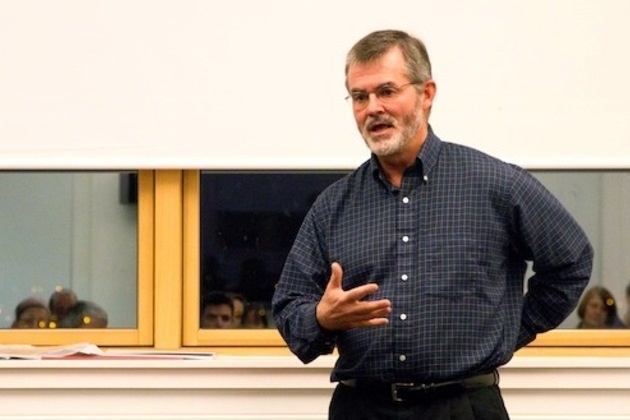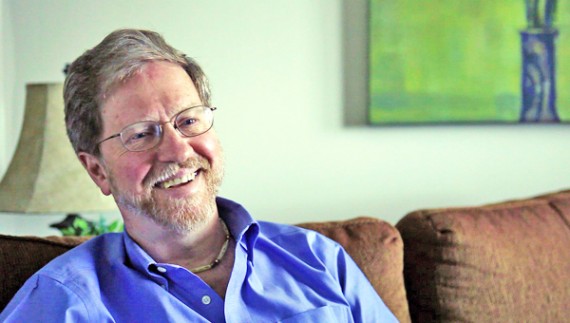
Author Robert Whitaker
Journalist and author Robert Whitaker has been a controversial figure in mental health circles since 2001 when he published his first book, Mad In America: Bad Science, Bad Medicine, and The Enduring Mistreatment of the Mentally Ill. In 2010, Whitaker’s book, Anatomy of An Epidemic: Magic Bullets, Psychiatric Drugs, and the Astonishing Rise of Mental Illness in America predictably sparked outrage and condemnation in many circles while it was loudly endorsed and applauded in others. An article by Whitaker in the non-peer-reviewed journal Medical Hypotheses, titled The case against antipsychotic drugs: a 50-year record of doing more harm than good should explain to those unfamiliar with his work why he has become such a lightening rod.
In April, Whitaker released a new book entitled: Psychiatry Under The Influence: Institutional Corruption, Social Injury, and Prescriptions for Reform, which he co-authored with Lisa Cosgrove, a fellow critic of the pharmaceutical industry and a professor at the University of Massachusetts in Boston. This book is aimed at more of an academic crowd than a mass audience.
Knowing how controversial Whitaker’s work is, I asked Virgil Stucker, executive director of CooperRiis Healing Community to write a review, which he was kind enough to send me.
Book Review: Psychiatry Under The Influence: Institutional Corruption, Social Injury, and Prescriptions for Reform
By Virgil Stucker
CooperRiis Healing Community
Bob Whitaker and Lisa Cosgrove’s 207 page book Psychiatry Under the Influence is packed full of provocative and thoughtful comments accompanied by detailed analyses of pharmaceutical research, clinical practice, organizational psychology and social philosophy. It reveals very troubling behaviors that have resulted from the confluence of the practice and promise of psychiatry with the profit seeking of pharmaceutical companies. Thought leaders in psychiatry, who have no financial ties to these companies, need to respond to its findings. It is also a book that should be read by everyone who seeks to help some of society’s most psychically vulnerable as well as by those who seek to help restore grit and resilience into daily life.
Thankfully, it is a book that also helps us to begin bridging the divide between the “It’s All-About-the-Medication” versus the “No-Medication” groups, also known as the Psychiatrists versus the Anti-Psychiatrists. These divided groups are much like the Fundamentalists versus the Atheists. Too often, these divides cause people to lose their heads, to stop listening and to react mindlessly. From my perspective this book is not fuel for the fire but is instead an honest and open expression of Whitaker and Cosgrove’s best efforts to show us compelling evidence of undue influence on psychiatry by pharmaceutical interests while suggesting a unifying path forward.
My perspective? My daily life (since 1975) is focused on caring for some of society’s most vulnerable in healing communities where over 40% of our residents have experienced a near lethal suicide attempt before coming to us, where nearly half are substance abusers and where all carry diagnoses of schizophrenia, schizo-affective disorder or the most extreme mood disorders, major depression, anxiety or bipolar disorders. Most seem to benefit from the optimized use of medications. Some choose not to use medications or to use them episodically. All voluntarily choose our program. Our psychiatrists work as members of a broader team that seeks to provide the best of psychology and neuroscience within a healing milieu.
Whitaker and Cosgrove’s book is more about the dramatic expansion of diagnostic descriptions into daily life than it is about this more seriously challenged group that I serve. As I began reading their book, I feared that its authors might become categorical regarding the use of psychotropic medication. Instead I found portions of the book that appear to find some value in the optimized use of Clozaril and even Haldol for the most psychotic and the use of anti-depressants for some of the most severely depressed. Additionally, it speaks of 29 years of the use of lithium for bipolar disorder before pharmaceutical companies realized that this arena also offered them a burgeoning market.
What this book is really about is the overmedicating and weakening of U.S. society over the last 35 years. Instead of using and building our grit and resilience to push through the normal despair and distress of daily living, we have turned that despair and distress into diagnoses and too quickly looked for a quick fix, in the form of a pill, as a solution. Since 1980 we have added hundreds of new diagnoses and new pills beginning with the DSM III and ending (currently) with the DSM 5. Nearly each new diagnosis calls for its own medication regimen. From 1987 to 2012, spending on psychiatric medications rose from $800M per year to $30B per year. Did our mental health improve? One negative correlation is that in 1987, 1.25M adults 18- 66 were assessed by the SSA as being disabled due to mental illness… by 2012 this number had increased to 4.2M. (Pg. 159) It’s difficult to find positive indicators of success!
What else was occurring during this time frame? In 1980, we were incarcerating 500,000 in our jails and prisons. Recently, the number hit about 2,500,000! A five-fold increase in 35 years; about 1 of every 139 of us is in jail or prison, more than any other nation in the world. ‘Only’ about 600,000 of the 2.5M carry a major psychiatric diagnosis. What concerns me as well is the rise of for-profit prisons, hungry for inmates, working deals with the courts to meet their quotas (and profits).
How are for-profit prisons different from for-profit pharmaceutical companies? Probably, very little. There is the presumption that for-profit companies need not pay attention to ethics as long as they are not breaking the law. Whitaker and Cosgrove write, “The public cannot expect drug companies to simply choose to alter their behavior to serve the public good.” (pg. 198) With that, they basically take the pharmaceutical companies off the hook. Not so fast! I think we do need to hold our corporations responsible for poor public outcomes. If we are recalling airbags that don’t work, shouldn’t we also be recalling medications that are ineffective? How about for-profit prisons that profit from increased recidivism? Perhaps that’s another book?
Whitaker and Cosgrove’s book does not address corporate responsibility and primarily seeks accountability from psychiatry. A response from the psychiatric community is called for. The research anomalies listed in this book need to be reviewed. One cannot simply lay Psychiatry Under the Influence back on the shelf and move on.
I know and respect many psychiatrists, many who are indeed increasing their personal accountability. Whitaker and Cosgrove speak of the impediments of the ‘guild’-effect, but I know many who are pushing through. Recently, I enjoyed a morning with Allen Frances, whose irreverence is encouraging. Peter Lake has also inspired me with his wisdom about how we need to restore grit and resilience in our young people. Sandy Steingard has pushed through guild convention and is finding her way, as is Jennifer Pasternack, a psychiatrist with whom I work almost daily. There are many others…
Consider that psychiatrists are attempting to deal with some of the most challenging aspects of human despair. If only it were as simple as surgically removing a tumor. It’s not. Dealing with the human psyche is more difficult. The medical disease model is insufficient. Change is underway. I know a number of psychiatrists who are moving from “bio-bio-bio psychiatry to bio-psycho-social” practices, an admonition from Steve Scharfstein as he completed his presidency of the APA. Additionally, I am inspired by Eric Plakun, who has incorporated this admonition into a new APA Caucus and helped to catalyze the interests of many others in this direction as well. A number of these psychiatrists are teaming up effectively with other mental health professionals, with all realizing that there are multiple options for providing care and support. I have met hundreds of psychiatrists and have yet to meet one who did not seem dedicated to his or her patients’ care.
I feel optimistic and think it is time for the ‘guild’ and policy leaders to consider Whitaker’s and Cosgrove’s reasonable recommendations in their last chapter, such as:
– Improve the regulations that govern pharmaceutical research so that outcomes will be influenced only by the science.
– Assure that all psychiatrists who sit on DSM panels and committees that set clinical practice guidelines have no financial relationships with pharmaceutical companies. The same would apply to officers and board members of the APA and its foundations.
– Endorse increased teamwork between psychiatrists and other mental health professionals, thereby, truly broadening practice from the more narrow bio-bio-bio approach to the bio-psycho-social spectrum.
In concluding my thoughts, I opened the Masters of Madness, Social Origins of the American Psychiatric Profession by Constance McGovern written in 1985 and read an account of the first meeting of what was to become the American Psychiatric Society on the 16th of October 1844. It is remarkable that their conversations seemed much about research – and its short comings – even back then. This is hard and worthy work and it may never be finished. We need to keep trying, sharing and healing the divides that have been too frequently distracting us.
 Virgil Stucker, founding Chairman and President of the Foundation for Excellence in Mental Health Care and current and founding Executive Director and President of CooperRiis Healing Community, has integrated his life with therapeutic communities since 1975 when he first started at Gould Farm, America’s oldest therapeutic community for individuals recovering from mental illness. Gould Farm, founded in 1913 in Massachusetts, is one of the models CooperRiis has followed.
Virgil Stucker, founding Chairman and President of the Foundation for Excellence in Mental Health Care and current and founding Executive Director and President of CooperRiis Healing Community, has integrated his life with therapeutic communities since 1975 when he first started at Gould Farm, America’s oldest therapeutic community for individuals recovering from mental illness. Gould Farm, founded in 1913 in Massachusetts, is one of the models CooperRiis has followed.
Virgil felt destined to help create therapeutic communities; after 14 years at Gould Farm, he was the founding Executive Director of Rose Hill in Michigan which opened in 1992 and of Gateway Homes of Richmond, Virginia which opened in 1986. In 1978 he was the founding Program Director of Gould Farm’s Boston Program.
Virgil also took some “sabbaticals” (as he puts it) from the life of therapeutic community, each of which further explored his interest in community and the power of relationships. In Massachusetts; he is past founding president of the REACH Community Health Foundation, Vice President of Planning and Development for Northern Berkshire Health Systems, President of the Berkshire Taconic Community Foundation, Senior Vice President of Legacy Banks, a community banking system, and Adjunct Professor of Philanthropy for the Visionaries Institute of Suffolk University. His degrees include an MBA with a focus on non-profit creation and management and a BA in philosophy. He graduated Phi Beta Kappa.
In addition to their personal involvement with therapeutic communities, Virgil and his wife Lis share their lives with their four children, two daughters-in-law, one son-in-law and seven grandchildren.
He has also served on 11 nonprofit boards and is an avid musician, playing mostly Native American flutes.
Virgil Stucker, (828) 899 4673, Virgil@CooperRiis.org



